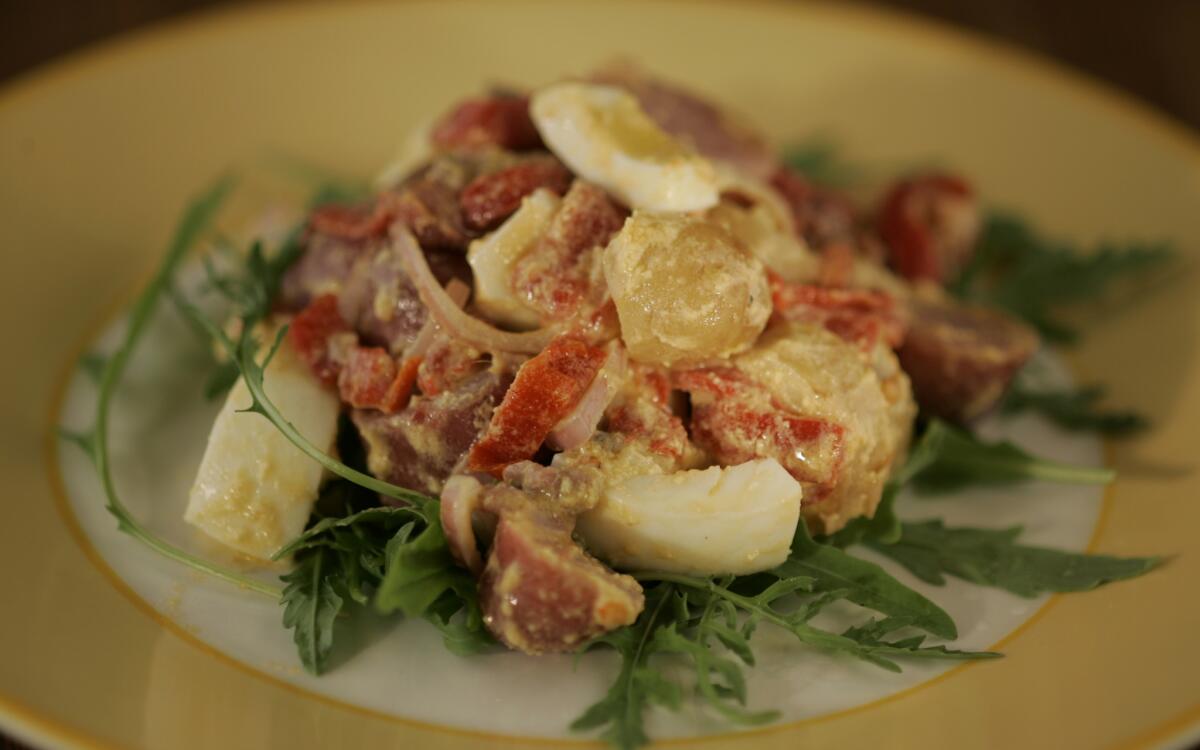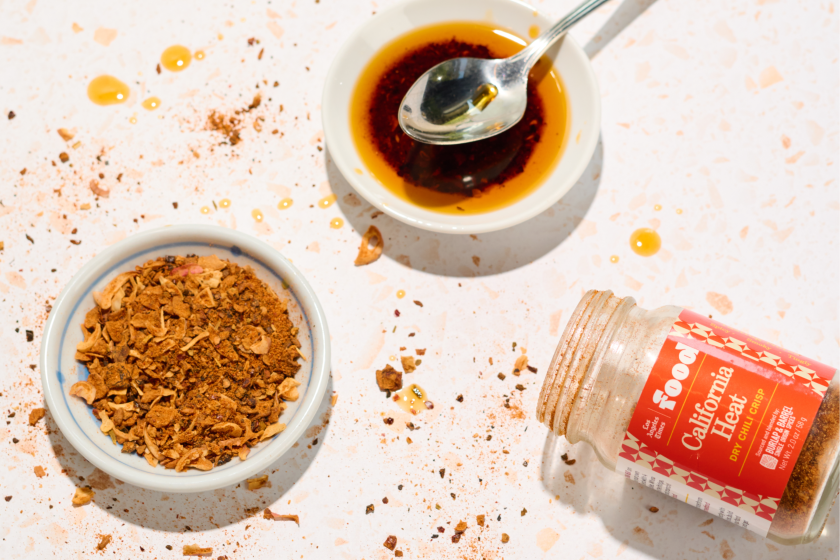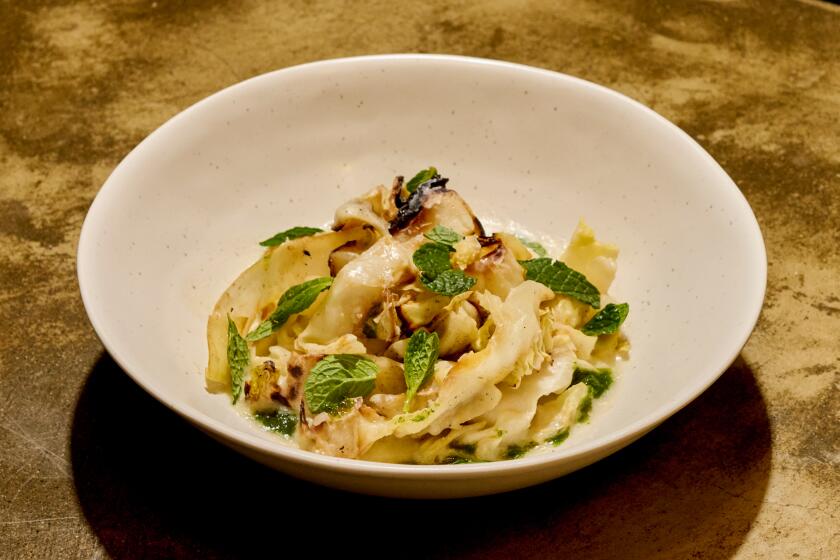Piquillo-potato salad with anchovies and eggs

- Share via
At an Italian restaurant in New York the other night, the inevitable little dish of olive oil with bread arrived with something different: radishes in a second little dish of oil with fat bits of anchovies strewn over them.
The combination was completely unexpected but tasted absolutely right: salty-rich against cold and crisp, with just enough of a hint of the sea to take the whole idea a notch beyond the French spread of butter and salt.
Ordinarily I prefer my anchovies undercover -- melded into a green goddess or Caesar dressing rather than splayed out over lettuce leaves -- but the crudite treatment gave me a renewed appreciation of the most useful canned food since the tomato. I had forgotten just how suited they are to summer, and the reason they turn up in every hot kitchen from Provence down to Sicily: You get flavor fast.
Anchovies are never anything you want to eat by the forkful, but if you combine them with the right partners, and treat them almost as a seasoning, they contribute a deeper, more intense, virtually rounded taste to any dish.
Used right, there’s nothing fishy about them.
The radish presentation was obviously a variation on bagna cauda, the Italian “warm bath” of anchovies in hot oil served as a dip for raw vegetables, which is the most classic and basic example of how to multiply flavor with tiny fillets. The same combination works equal sorcery with any other raw vegetables, whether cherry tomatoes or zucchini, and even steamed corn on the cob. And when you add vinegar to the mixture, you get a classic dressing for salad or asparagus.
When anchovies are added to a cooked dish, the flavor mystique only intensifies. I always use a few (or a fat squeeze of anchovy paste) in tomato sauce for pasta to give it that meaty aspect when there’s no time to simmer something for an hour. And, of course, I’m following in the noble steps of the Italian prostitutes who devised puttanesca sauce when they needed to get food to their families in a hurry after spending the afternoon otherwise engaged. Their innovation, with capers and olives, is an idea too good to limit to linguine: The same sauce makes an excellent topping for bruschetta, like salsa with resonance.
I’ve been using anchovies with grilled or steamed eggplant ever since trying a recipe from a cookbook by Jacques Maximin of Nice. It was a disaster as the pate he billed it as, but fabulous as a puree. Like anchovies, eggplant can taste almost meaty; add good olive oil and lots of fresh basil when you put the two in the blender and the combination will be much more than the parts as a side dish. Or even a sauce.
Best fast sauce
A grilling friend who apparently knows exactly one recipe also taught me the best fast sauce for swordfish or tuna: Mash a few anchovies into butter and let it melt over the steaks. The same simple idea can transform roasted or grilled vegetables, particularly a combination of sliced zucchini and shiitake mushrooms, if you substitute great olive oil for the butter and toss in a little herbes de Provence. You won’t taste anchovies overtly, only an indefinable richness.
Even fully exposed anchovies can blend into the background. On pissaladiere -- the Provencal flatbread-tart covered with them -- the pungent oil-cured olives balance their aggressiveness while the anchovies just about melt into the sweet braised onions. And in a potato salad, you can use an entire tinful if you start with very flavorful piquillo peppers and hard-cooked eggs, which go with anchovies the way bacon does with tomatoes (and eggs).
Anchovies are so versatile I always have at least as many cans in my kitchen cabinet as tomatoes and black beans. Quick flavor should always be at arm’s reach -- especially in summer.
Place the potatoes in a medium saucepan with the bay leaves, garlic and 1 teaspoon salt. Add water to cover and bring to a boil. Reduce the heat and simmer until the potatoes are easily pierced with a knife, about 15 minutes (time will vary depending on type and age of potatoes). Drain well. Cool slightly.
While the potatoes cook, place the eggs in a small saucepan with water to cover. Add one-half teaspoon salt and the cider vinegar. Bring to a boil, reduce the heat and simmer for 10 minutes. Drain and place under cold running water until cool.
Slice the potatoes crosswise into half-inch pieces and place in a bowl. Add the chopped anchovies. Cut the piquillos in half lengthwise, then crosswise into thin strips. Add them to the potatoes. Cut the shallot in half lengthwise, then crosswise into very fine slices and add.
Cut the eggs in half lengthwise and scoop out the yolks. Press the yolks through a small strainer into a small bowl. Set aside. Cut the whites in half lengthwise and then crosswise into half-inch thick strips and add to the potatoes. Toss the potato mixture with a fork until the ingredients are well mixed.
To the yolks, add the mayonnaise, vinegar and olive oil and mix gently until smooth and well combined. Pour the dressing over the potato mixture. Mix together with a rubber spatula until the ingredients are well distributed and lightly dressed. Season with salt and pepper to taste. Add more chopped anchovies if desired.
To serve, lay the arugula in a salad bowl or on serving plates and mound the potato salad over.
Get our Cooking newsletter.
Your roundup of inspiring recipes and kitchen tricks.
You may occasionally receive promotional content from the Los Angeles Times.













